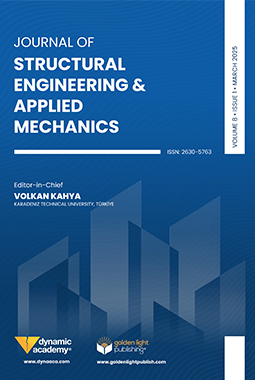ISSN:2630-5763
Journal of Structural Engineering & Applied Mechanics
ARTICLES
Haluk Görkem Alcan
Barış Bayrak
Ali Öz
Oğuzhan Çelebi
Gökhan Kaplan
Abdulkadir Cüneyt Aydın
This paper focuses on sustainability and innovative materials in the construction industry. The study addresses the mechanical and high-temperature resistance (200 °C, 400 °C, and 600 °C) of SIFGEO, a superior composite material, by combining geopolymer concrete (GPC) and slurry-infiltrated fiber concrete (SIFCON) technologies. Within the scope of the study, the main binder in the SIFGEO specimens is blast furnace slag (BFS), and one group was produced only based on BFS. In the other groups, 10% were added by mass silica fume (SF), metakaolin (MK), and rice husk ash (RHA) instead of slag. As a result of the mechanical tests of the specimens that were not exposed to high temperatures, it was determined that the mixture containing only BFS as a binder had the highest compressive strength, flexural strength, and specific fracture energy. The compressive and flexural strengths of the mixture containing only BFS as a binder were 62.24 and 22.03 MPa, respectively, and the fracture energy was approximately 2146 N/m. The lowest results were obtained in the mixture where RHA was used as a partial replacement for BFS, with compressive strength, flexural strength, and fracture energy measured as 41.31 MPa, 16.81 MPa, and 1346.4 N/m, respectively. The compressive strength, flexural strength, and fracture energy of all mixtures showed a decreasing trend with increasing temperatures. It was observed that dense steel fibers provided effective crack control and increased ductility in both non-high temperature and high temperature exposed samples. In addition, depending on the parameters within the scope of the presented study, the correlation between the experimental results on SIFGEO samples was examined. In addition, statistical analyses were conducted to evaluate the relationships between the mechanical parameters. A strong correlation was found between flexural strength and fracture energy (R² values between 0.86 and 0.98) and between flexural strength and compressive strength (R² values between 0.89 and 0.96) for different binder types and temperature conditions. These results confirm that changes in flexural strength are closely linked to both fracture energy and compressive strength in SIFGEO specimens.
https://doi.org/10.31462/jseam.2025.03175199
Merve Bayraktutan
Dilek Okuyucu
Sena Refayeli
Yusuf Özbağ
İbrahim Şahud
Kurtuluş Yılmaz
Türkiye has a large building stock requiring seismic performance evaluation. Law No. 6306, enacted in 2012, governs the identification and renewal of risky structures. In this context, a seismic assessment was conducted on a four-story reinforced concrete building. A finite element model was developed, and theoretical modal analysis yielded a fundamental vibration period of 1.220 seconds. Due to this high value, an operational modal analysis was performed, revealing a period of 0.240 seconds. Comparison with the regional horizontal elastic design spectrum indicated that neglecting the stiffness contribution of infill walls in the model could lead to seismic loads approximately 5.1 times higher than realistic values, which may result in a significantly inaccurate performance assessment.
https://doi.org/10.31462/jseam.2025.03200219
Fezayil Sunca
In vibration tests, the number and placement of sensors play a critical role in ensuring the quality of vibration signals and the reliability of identified modal parameters. For effective structural identification, it is essential to select sensor locations that enable accurate tracking of structural behavior with minimal instrumentation. In this study, the applicability and effectiveness of optimal sensor placement for identifying modal parameters of a steel–timber composite beam using ambient vibration tests were investigated. To this aim, a beam was constructed under laboratory conditions, and vibration tests were performed to determine its modal parameters. Initially, ambient vibration tests of the beam were performed using a large number of accelerometers. Subsequently, the optimal sensor layout was determined using the Effective Independence method, and the vibration tests were repeated accordingly. Experimental modal parameters were extracted using the Enhanced Frequency Domain Decomposition method. A comparative analysis revealed that the EFI-based optimal sensor configuration effectively captured the key modal parameters with fewer sensors, thereby maintaining reliability and accuracy. This demonstrated that optimal sensor placement could significantly reduce instrumentation without compromising the quality of identification.
https://doi.org/10.31462/jseam.2025.03220231
Fatih Yesevi Okur
Concrete arch dams rely on energy dissipation through material damping and boundary interactions to attenuate seismic vibrations, yet quantitative field measurements of damping under real operating conditions are scarce. In this study, we present a comprehensive damping assessment of the 275 m-high Yusufeli Arch Dam during its reservoir impoundment phase (2022–2025). Six low-magnitude earthquakes (Mw 4.0–5.0) provided crest‐level acceleration records via a centrally located tri‐axial sensor. A multi-band logarithmic-decrement technique was employed, with filter frequencies adjusted according to real-time water-level–dependent natural frequencies. The resulting damping ratios ranged from 0.8 % to 4.7 % (mean 1.95 %, COV 23 %), revealing a strong amplitude dependence: higher crest peak accelerations corresponded to increased damping, while no clear trend emerged with reservoir fill level. These results demonstrate that under service-level seismic inputs, a constant damping ratio of 1 %–2 % can be reliably assumed across impoundment stages, with higher values only necessary for stronger shaking. The methodology’s reliance on a single, easily maintained sensor and direct response data offers a practical approach for structural health monitoring and model calibration. By decoupling damping from continuous hydraulic loading variations and focusing on measured excitation amplitude, this framework enhances the accuracy of seismic response simulations and supports more effective maintenance and risk‐mitigation strategies for large arch dams.
https://doi.org/10.31462/jseam.2025.03232245


